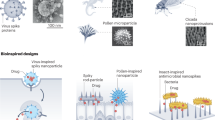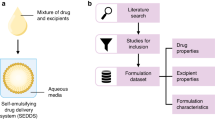Key Points
-
The principles of materials science have been applied in many areas of chemistry, but have not found general application in the discovery and development of active pharmaceuticals ingredients (APIs). There is now a growing understanding of the importance of solid-state and physico-chemical properties of APIs in influencing their acceptability as marketable drugs.
-
Until now, medicinal chemists have not had at their disposal the means to explore and evaluate physico-chemical properties of drug candidates in a time frame consistent with the turnaround of other assays for potency, selectivity and metabolism that are used in structure–activity calculations.
-
The development of high-throughput experimentation (HTE) platforms to rapidly create and characterize solid-state forms and formulations of APIs using very small amounts of compound opens up opportunities for co-optimizing not only potency and selectivity but physical properties during the lead optimization process.
-
These HTE techniques can provide valuable information to the scientists responsible for formulation design and scale up of chemical and pharmaceutical processes.
-
In addition, the information accumulated on crystal forms provides added intellectual property to protect the active moiety.
Abstract
Traditionally, potency and selectivity (and to some extent metabolism) have been the key parameters to consider in the process of discovering new drug candidates. Recently, heads of research and CEOs have been learning a new reality: drugs can move around the body and act at the molecular level, but the chemical and material properties of their physical form need to be identified and optimized for in vivo performance, reliable manufacture and the protection of intellectual property. This review discusses the challenge of pharmaceutical materials discovery, and suggests strategies for addressing the characterization and evaluation of physico-chemical and material properties in the drug discovery and development process.
This is a preview of subscription content, access via your institution
Access options
Subscribe to this journal
Receive 12 print issues and online access
$209.00 per year
only $17.42 per issue
Buy this article
- Purchase on Springer Link
- Instant access to full article PDF
Prices may be subject to local taxes which are calculated during checkout





Similar content being viewed by others
References
GlaxoSmithKline on track to launch 11 drugs by Dec. 2003. Dow Jones Newswires 8 September (2003).
Tobin, E. & Hirshcler, B. Raising the quality and cost bar for drug makers. Reuters Company News 7 August (2002).
US FDA. FDA completes first step of its broad initiative to improve regulation of pharmaceutical manufacturing [online], <http://www.fda.gov/bbs/topics/NEWS/2003/NEW00872.html> (2003).
Abboud, L. & Hensley, S. New prescription for drug makers: Update the plants. Wall Street J. 3 September (2003).
Mathews, A. W. & Hensley, S. FDA explores obstacles to new drugs. Wall Street J. 16 March (2004).
FDA's overhaul of GMP oversight will include numerous targeted guidances. The Pink Sheet 22 March (2004).
Slowik, H. The battle for IP. In Vivo 21, 75–84 (2003).
Lipinski, C. A., Lombardo, F., Dominy, B. W. & Feeney, P. J. Experimental and computational approaches to estimate solubility and permeability in drug discovery and development settings. Adv. Drug. Deliv. Rev. 23, 3–25 (1997). This paper demonstrates that solubility and other physical parameters can be used to address the probability that a compound could behave like a drug; Lipinski and co-workers suggested the 'rule of five' as a guide to addressing physico-chemical deficiencies of hits and lead compounds.
Milne, G. M. Pharmaceutical productivity the imperative for a new paradigm. Annu. Rep. Med. Chem. 38, 383–396 (2003).
Datta, S. & Grant, D. J. Crystal structures of drugs: advances in determination, prediction and engineering. Nature Rev. Drug Discov. 3, 42–57 (2004). A highly recommended, recent and comprehensive review of the efforts in prediction, analysis and engineering of crystal structures of pharmaceuticals.
Lin, J. H. Role of pharmacokinetics in the discovery and development of indinavir. Adv. Drug Deliv. Rev. 39, 33–49 (1999).
Abbott Laboratories, Inc. Abbott announces difficulty manufacturing Norvir® (Ritonavir) capsules. Press Release 27 July (1998).
Bauer, J. et al. Ritonavir: an extraordinary example of conformational polymorphism. Pharm. Res. 18, 859–866 (2001). A summary of the factors that were probably responsible for the polymorphic shift of ritonavir, which led to a product recall and major reformulation efforts.
Morissette, S. L., Soukasene, S., Levinson, D., Cima, M. J. & Almarsson, Ö. Elucidation of crystal form diversity of the hiv protease inhibitor ritonavir by high-throughput crystallization. Proc. Natl Acad. Sci. USA 100, 2180–2184 (2003).
Morissette, S. L. et al. High-throughput crystallization: polymorphs, salts, co-crystals and solvates of pharmaceutical solids. Adv. Drug. Deliv. Rev. 56, 275–300 (2004). This article provides a current review of the high-throughput systems and methodologies for discovering, analysing and classifying the physical forms of drug substances.
Almarsson, Ö. & Gardner, C. R. Novel approaches to issues of developability. Curr. Drug Discov. January, 21–26 (2003).
Desrosiers, P. J. The potential of preform. Modern Drug Discov. January, 40–43 (2004).
Storey, R. A., Docherty, R. & Higginson, P. D. Integration of high-throughput screening methodologies and manual processes for solid form selection. Am. Pharm. Rev. 100–105 (2003).
Sims, J. L., Roberts, J. K., Bateman, A. G., Carreira, J. A. & Hardy, M. J. An automated workstation for forced degradation of active pharmaceutical ingredients. J. Pharm. Sci. 91, 884–892 (2002).
Almarsson, Ö. et al. High-throughput surveys of crystal form diversity of highly polymorphic pharmaceutical compounds. Crystal Growth Des. 3, 927–933 (2003). A detailed survey of the real extent of crystal polymorphism of sertraline HCl, the active ingredient in Zoloft.
Remenar, J. F. et al. Salt selection and simultaneous polymorphism assessment via high-throughput crystallization: the case of sertraline. Organic Process Res. Dev. 7, 990–996 (2003). A follow-up study on sertraline that illustrates how similar salt forms of the same base can behave dramatically differently although the HCl salt displays several different crystalline forms, the HBr salt is not overtly polymorphic.
Morissette, S. L. et al. High-throughput crystallization of polymorphs and salts: applications in early lead optimization. Abstracts of Papers, 225th Am. CHem. Soc. Natl Mtg, New Orleans, USA 23–27 March (2003).
Remenar, J. F. et al. Crystal engineering of novel co-crystals of a triazole drug with 1,4-dicarboxylic acids. J. Am. Chem. Soc. 125, 8456–8457 (2003).
Lemott, M. et al. Validation and application of a high throughput formulation platform for the identification of suitable oral and iv animal dosing vehicles. Am. Assoc. Pharm. Sci. Mtg 30 October (2003).
Chen, H. et al. A high-throughput combinatorial approach for the discovery of a cremophor EL-free paclitaxel formulation. Pharm. Res. 20, 1302–1308 (2003). This study is an example of reformulation of an injection that led to alterations of pharmacokinetics of the poorly soluble, lipophilic drug paclitaxel.
Gardner, C. R. et al. Application of high-throughput technologies to drug substance and drug product development. Comp. Chem. Eng. 28, 943–953 (2004).
MacCoss, M. & Baillie, T. A. Organic chemistry in drug discovery. Science 303, 1810–1813 (2004). A call to organic chemists to understand and contribute to the integrated efforts across compound synthesis and metabolism mechanism evaluation.
Lucas, J. & Burgess, P. When form equals substance: the value of form screening in product life-cycle management. Pharma Voice, 54–57 (2004). A legal analysis and perspective on the value of forms to a drug's patent estate, with examples and explanations of terminology.
Landers, P. Drug industry's big push into technology falls short. Wall Street J. 24 February (2003).
Acknowledgements
The authors acknowledge helpful discussions with the scientists at TransForm Pharmaceuticals and several large pharmaceutical companies.
Author information
Authors and Affiliations
Corresponding author
Ethics declarations
Competing interests
C.R.G. and O.A. are emloyees of TransForm Pharmaceuticals, Inc.
C.T.W. is on the Board of Directors of TransForm Pharmaceuticals, Inc.
All three authors hold stock options in TransForm Pharmaceuticals, Inc.
Related links
Glossary
- STRUCTURE–ACTIVITY RELATIONSHIPS
-
Correlations that are constructed between the features of chemical structure in a set of candidate compounds and parameters of biological activity, such as potency, selectivity and toxicity.
- POLYMORPH
-
A compound of a defined chemical composition that exists in more than one molecular arrangement and/or conformation in the solid state.
- ACHLORHYDRIA
-
Condition of relative absence of hydrochloric acid (HCl) from gastric juice (common in dogs due to pulsatile secretion of HCl in their stomachs, as well as in humans as a result of disease or age) that can have a dramatic effect on oral absorption of weak base compounds.
- HIT
-
A compound, form or formulation satisfying an initial set of criteria (for example, minimum potency and solubility), but requiring elaboration or validation through further detailed analysis of performance or additional iterations.
Rights and permissions
About this article
Cite this article
Gardner, C., Walsh, C. & Almarsson, Ö. Drugs as materials: valuing physical form in drug discovery. Nat Rev Drug Discov 3, 926–934 (2004). https://doi.org/10.1038/nrd1550
Issue Date:
DOI: https://doi.org/10.1038/nrd1550
This article is cited by
-
In silico screening of dicarboxylic acids for cocrystallization with phenylpiperazine derivatives based on both cocrystallization propensity and solubility advantage
Journal of Molecular Modeling (2017)
-
A Review of Disintegration Mechanisms and Measurement Techniques
Pharmaceutical Research (2017)
-
Assessing inhibitors of mutant isocitrate dehydrogenase using a suite of pre-clinical discovery assays
Scientific Reports (2017)
-
Solid–solid phase transitions via melting in metals
Nature Communications (2016)
-
Clustered Distribution of Natural Product Leads of Drugs in the Chemical Space as Influenced by the Privileged Target-Sites
Scientific Reports (2015)



